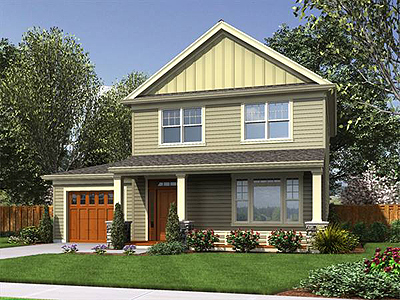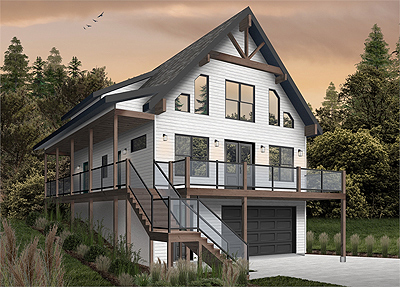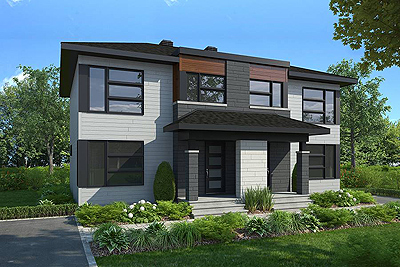How to Build an Affordable House
by Rachel Lyon, Editorial Director for Direct from the Designers™
If the idea of building your own home seems like an immense undertaking, but if you want to own rather than rent, you should know that it can actually be more affordable to build than to buy! Building puts you in control of every decision, allowing you to invest in a home that works for your needs without spending extra on unnecessary frills. This flexibility can go a long way, so here’s what you should know to build affordably!

Look for Simple Shapes
Once you know what you’re looking for in a house, you get to go through all the options to find the design that makes the most sense for you. Parameters like square footage and number of bedrooms and bathrooms are just the very beginning—those basics can be packaged all sorts of ways to suit various budgets and tastes. And make sure not to forget about lot requirements, as the dimensions of your house will be affected by the shape/size of your lot as well as any restrictive covenants and zoning rules.
For example, many jurisdictions have lot coverage regulations that mean you have to build up rather than out if you want more square footage. Some places have conservation easements that mean you can’t develop certain portions of the land; while this might seem like a turnoff, it can actually save money because fewer people want to buy restrictive plots and they cost less as a result, and the easement can benefit you when it comes to taxes. Then there are things like property and utility easements. When in doubt, go to your building department or town hall, or ask your builder, so you can make a well-informed decision about where to place the house.
Once you have a handle on the dimensions you have to work with, it’s time to select a house plan. Here’s what to look for if you need to stay mindful of a tight budget:
Footprint – The simpler the shape of the foundation, the less it’ll cost to build. Opt for a rectangle to get the most bang for your buck at any size!
Rooflines – Complex roofs with various shapes and pitches add up quickly, and can make even a small house very expensive. Limit the number of shapes (gable, hipped, shed, etc.) and intersections to save.
Minimize Lot Coverage – The foundation and roof are the most expensive parts of constructing a home, so a two-story house is much more affordable than a one-story house of the same square footage. Consolidate as much as you can.
The moral here is to keep it simple! It’s easy to get caught up looking at flashy designs, but all those unique elements significantly increase the cost to build. It’s better to put your money into higher quality materials and interior features to increase value.

Build for Efficiency
You can build efficiently and build for efficiency to save money now and in the future. Believe it or not, efficiency is determined from the very beginning, so before you select energy-efficient products to put inside, look at what you’re putting them into. And take a step back to look at the broader picture before making any decisions, because you might find savings where you least expect them. For instance, if you’d consider paying more up front to reduce costs on the worksite, SIPs could be the way to go for framing—learn more about this in our article, The Benefits of Building with SIPs. In any case, get quotes and compare options to find where you can save.
If you want to build an efficient house, keep these things in mind:
Shape – Here it is again! Simply shaped houses are easier to make airtight and insulate to reduce air leakage, which works against your HVAC system. Reduce the strain on the system and you’ll save on utilities.
Framing – Standard stick framing is 2x4, but many architects design with thicker 2x6 exterior walls these days to increase efficiency. If this option doesn’t come standard, it can be done through modifications. Concrete blocks and SIPs also build more efficient homes, but they cost more up front.
Fixtures – Plumbing fixtures designed to use less water will reduce your water bill going forward. Everything from toilets, to sink faucets, to shower heads can make a difference.
Appliances – Efficient appliances will slash your electricity bill. While all are important, the refrigerator uses the most energy by far, so invest here if nowhere else!
Many people have difficulty selecting finishes for their new homes. Take a look at our New Home Resources page if you need any tips, recommendations, or inspiration—we cover a wide variety of topics to help make it easier.

Consider Investment Potential
Nowadays, a fair number of people building homes choose designs with more than one dwelling, whether that means they select a duplex or a house that includes a small apartment. They do this with the intent to generate income and thus reduce the weight of their mortgage. So, think about it—could you see yourself being a landlord, or maybe a vacation rental host? Building two dwellings in one structure costs a lot less than if they were separate, so it’s prudent to invest in the idea early. It will cost more to finish the house—primarily due to the double kitchens—but it can help you pay down the mortgage a lot faster, too.
Wherever you are in your journey, we’re here to help! Our home plan advisors can help you find and/or modify the perfect house for your needs, provide insight into the building process, and answer any questions you have. Feel free to reach out when you’re ready!
BROWSE HOME PRODUCT ARTICLES
- Creating a Spa-Like Master Bathroom »
- Designing a Water-Efficient Bathroom »
- Design a Modern Bathroom »
- View All Bathroom Articles »
- Building a New Home »
- Building a Duplex »
- Finding the Right Home Builder »
- View All Building Tips Articles »
- Adding the Right Columns»
- Decorative Touches for Your Interior»
- Shutters for Every Architectural Style »
- View All Columns & Millwork Articles »
- How to Use Specialty Laminates »
- Decorative Touches for Your Home's Interior
- View All Countertops and Surfaces Articles »
- What Goes Into a Great Deck? »
- Decorative Touches for Your Home's Interior »
- View All Decking Articles »
- Choosing Glass for Your Entry »
- Stylish Personas for Your Front Door »
- Using Sidelites and Transoms »
- View All Door Articles »
- Choose Siding for Your Region »
- Get the Most Out of Exterior Paint »
- Mixing Siding to Define Your Exterior »
- View All Exterior Articles »
- Finding the Right Home Builder »
- The Appeal of Small House Plans »
- Choosing the Perfect Floor Plan »
- View All Finding a Home Plan Articles »
- Colorful Flooring for Your Home »
- Designing With Different Widths»
- Chic, Neutral, Gray Flooring »
- View All Flooring Articles »
- Garage Doors That Add Curb Appeal »
- Caring for Your Garage Doors »
- Benefits of Insulated Garage Doors »
- View All Garage Door Articles »
- Reclaimed Products for Your Home »
- Building a Green and Stylish Home »
- Benefits of Building with SIPS »
- View All Green Building Articles »
- Cool Gadgets for Your New Home »
- Creating a Hi-Tech Home »
- Efficient Gifts for New Homeowners »
- View All Home Electronics Articles »
- Improve Your Home's Air Circulation »
- How to Improve the Air Circulation in Your Home »
- View All HVAC Articles »
- Bedrooms Designed for Sleep »
- Selecting a Fireplace for Your Home »
- Crafting a Luxurious Master Suite »
- View All Interior Design Articles »
- Design the Perfect Outdoor Space »
- Dive into a Beautiful Pool »
- Design a Sizzling Outdoor Kitchen »
- View All Outdoor Living Articles »
- Apps to Help You Pick Paint Colors »
- Create the Perfect Mood with Paint »
- How to Read the Color Wheel »
- View All Painting & Decorating Articles»
- Creating a Spa-Like Master Bathroom »
- High-Impact Kitchen Upgrades »
- Creating a Water Efficient Bathroom »
- View All Plumbing Fixtures Articles»
- Cladding That Complements Your Exterior »
- Reasons to Consider Prefinished Siding »
- View All Siding & Cladding Articles»
- All About Solar Powered Skylights »
- Natural Lighting for the Dark Corners of Your Home »
- Design a Better Bedroom with Skylights »
- View All Skylight Articles»
.png)
.png)
